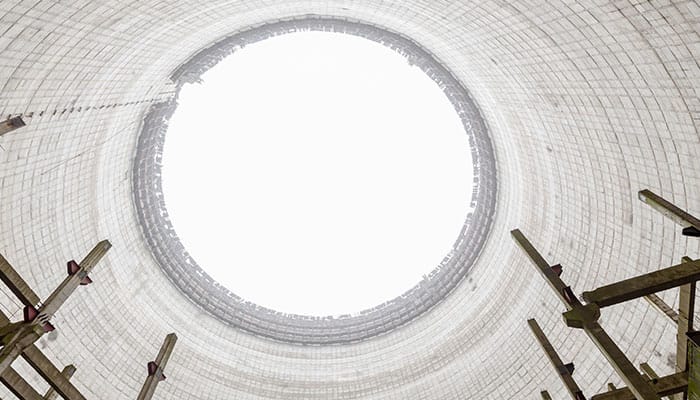Cooling towers play a critical role in temperature regulation across a wide range of industries. From power generation plants to manufacturing facilities, these systems help to dissipate heat and prevent equipment from overheating and maintain operational efficiency. Selecting the right cooling tower materials requires an understanding of its design, functionality, and material composition. Given the constant exposure to moisture, chemicals, and temperature fluctuations, corrosion-resistant FRP panels from Stabilit America have become the best choice for structural components such as louvers, enclosures, and exterior casing.
How Cooling Towers Work
At their core, cooling towers function as heat rejection systems that work to remove excess heat from industrial processes by evaporating a portion of the circulating water. This process helps lower the temperature of the remaining water, which is then recirculated to absorb more heat from the system.
The efficiency of a cooling tower depends on several factors, including:
- Water circulation rate: The volume of water moving through the system impacts the overall cooling capacity.
- Airflow mechanism: Some cooling towers rely on natural airflow or mechanical fans to facilitate heat exchange.
- Design configuration: Different types of cooling towers optimize cooling performance based on the industry-specific needs of the structure that is being supported.
Cooling towers are effective, but they still require routine maintenance to prevent scaling, biological growth, and efficiency losses. Without proper upkeep, you could see reduced heat transfer, increased energy consumption, and even structural degradation.
Types of Cooling Towers
Cooling towers are classified based on how they facilitate heat transfer. The four primary types include:
1. Natural Draft Cooling Towers
These towers use their height and shape to generate natural airflow, eliminating the need for mechanical fans. You commonly see them used in power plants where they are highly efficient. You should keep in mind that they do require significant space and are costly to construct.
2. Mechanical Draft Cooling Towers
Unlike natural draft designs, mechanical draft towers use fans to force air through the system as a way to increase cooling efficiency. These towers are further divided into two subtypes:
- Forced draft towers push air through the fill media using fans at the base.
- Induced draft towers have fans at the top to pull air upward to optimize heat dissipation.
3. Crossflow Cooling Towers
In a crossflow system, air moves horizontally while water flows vertically through the fill media. These towers allow easier maintenance access and operate with lower energy consumption but can be more prone to freezing in colder climates.
4. Counterflow Cooling Towers
Designed for maximum efficiency, counterflow towers move air in the opposite direction of water flow, increasing the rate of heat exchange. While they require more power for water distribution, they generally provide better cooling performance and are commonly used in industrial applications.
Cooling Towers vs. Chillers: What’s the Difference?
Cooling towers and chillers both manage heat dissipation, but they are not the same thing since they function differently. A cooling tower removes heat from process water through evaporation, making it a good option for industrial applications. On the other hand, a chiller uses refrigerants to absorb and expel heat. They provide precise temperature control in climate-sensitive environments like hospitals and laboratories.
A lot of facilities actually use both systems together, with cooling towers handling large-scale heat rejection and chillers to maintain the cooling temperatures required. The choice between the two depends on factors like energy efficiency, water consumption, and operational requirements.
Key Industries That Rely on Cooling Towers
Cooling towers support a variety of industries by maintaining optimal temperatures for equipment and processes. Some of the most common applications include:
- Power Plants: Essential for steam condensation and waste heat removal in thermal and nuclear power generation.
- Manufacturing Facilities: Regulate temperature in industrial processes such as metal fabrication, plastic molding, and chemical production.
- Data Centers: Prevent overheating of server rooms by efficiently rejecting excess heat.
- Petrochemical and Refining: Support cooling requirements for oil refineries and chemical processing plants.
- HVAC Systems: Provide temperature regulation in commercial buildings, hospitals, and large residential complexes.
Regardless of the application, you need materials for your construction that can withstand extreme conditions to allow for long-term performance.

FRP Panels: Enhancing Cooling Tower Durability
Cooling towers are constantly exposed to moisture, airborne contaminants, and corrosive chemicals. Traditional materials like wood and metal can deteriorate over time, leading to frequent maintenance, costly repairs, and structural instability.
FRP panels provide an advantage through all the hazards that your facility will be exposed to. Designed for corrosion resistance, impact durability, and minimal maintenance, FRP panels are used for louvers, stair enclosures, and exterior casing. Stabilit America’s Opalit Cooling Tower FRP Panels meet the demanding conditions of cooling tower environments, ensuring long-lasting performance with minimal degradation.
Benefits of using FRP panels in cooling towers include:
- They are resistant to chemicals and moisture through the prevention of rusting, rotting, and degradation.
- Our panels create lightweight construction, simplifying the installation and reducing the structural load.
- You get enhanced durability. Our panels maintain their integrity under harsh weather conditions.
- Fire-resistant properties meet industry standards for safety compliance.
By incorporating FRP solutions from Stabilit America, cooling tower systems get greater operational efficiency, lower maintenance costs, and extended service life.
Cooling Tower Maintenance Best Practices
Regular maintenance is important to keep a cooling tower running at peak efficiency. Neglecting upkeep can lead to scale buildup, corrosion, biological contamination, and mechanical failures.
Routine Inspection Checklist
- Check for leaks: Inspect all piping, valves, and structural panels for any signs of deterioration.
- Clean the basin and sump: Remove debris and sediment to prevent clogging and microbial growth.
- Monitor water quality: Test for pH levels, total dissolved solids, and microbial contaminants.
- Inspect fan systems: Make sure all the fans and motors are free of dust buildup and that they are operating at full capacity.
- Evaluate drift eliminators: Replace damaged components to minimize water loss.
Seasonal Maintenance Tips
- Spring Startup: Flush out sediment, inspect nozzles, and verify water distribution systems.
- Summer Operation: Monitor water treatment levels to prevent scaling and corrosion.
- Fall Shutdown: Drain the system, clean components, and apply protective coatings if necessary.
- Winterization: In colder climates, implement freeze protection measures to prevent damage.
Optimize Your Cooling Tower’s Performance With Durable Solutions
Cooling towers are indispensable in industrial and commercial applications, providing reliable heat dissipation. Selecting the right tower type, performing routine maintenance, and utilizing corrosion-resistant materials like FRP panels can improve performance, longevity, and cost efficiency. With an increasing demand for sustainable and energy-efficient cooling solutions, materials from Stabilit America offer long-term advantages in reducing maintenance efforts and improving structural durability. When you’re looking for a reliable, low-maintenance, and high-performance cooling tower solution, integrating FRP-based components is a forward-thinking investment. Contact us today to find out how our products can improve your cooling tower construction.


